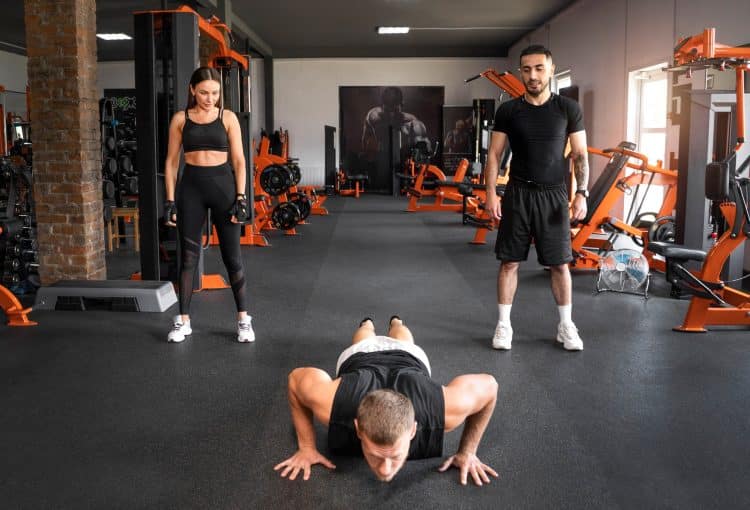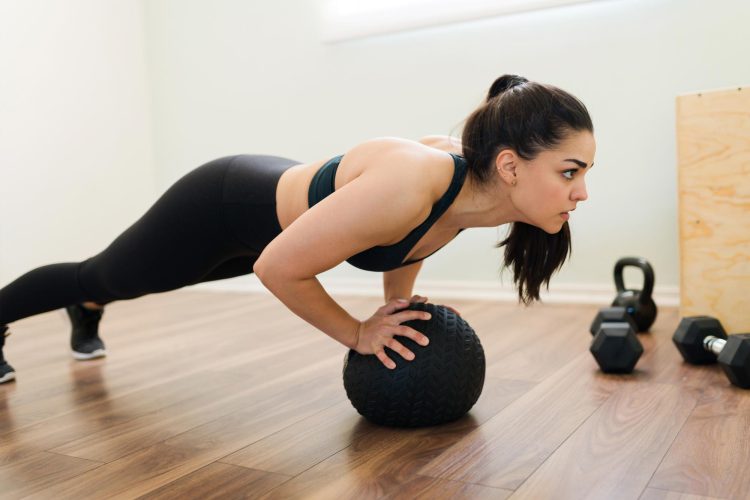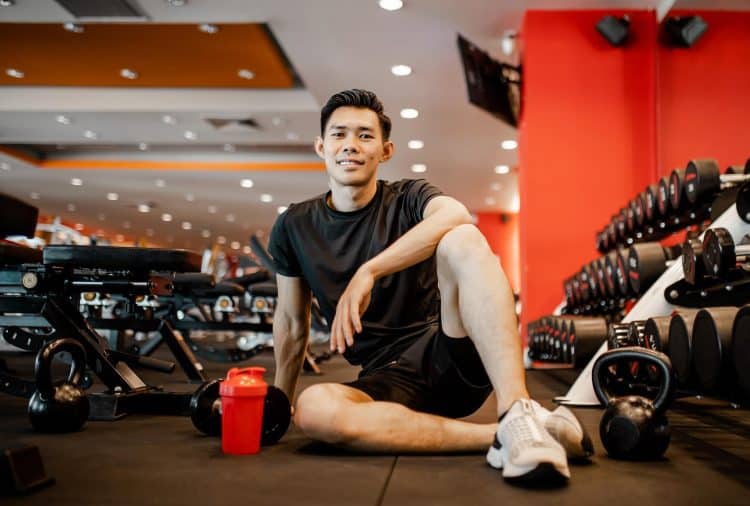As a personal trainer who has spent the majority of the last 17 years in the gym, I can attest that isolation exercises are a hit among lifters. Bicep curls, chest flyes, side lateral raises, and leg extensions are all examples of isolation movements.
There are several reasons why people prefer isolation exercises — they deliver a solid pump, are usually less fatiguing than compound movements, and have a lower risk of injury.
However, training one muscle group at a time isn’t the most optimal approach for improving your overall physique aesthetics, maximizing calorie burn, or improving functional fitness, which can help boost your performance in day-to-day activities.
This is where full-body workouts shine!
Full-body routines can help you build a solid foundation by engaging multiple muscle groups simultaneously. In this article, I’ll pull back the curtain on how you can make the most of this training approach to maximize fat loss and build muscle.
The Science of Full-Body Workouts
Level Up Your Fitness: Join our 💪 strong community in Fitness Volt Newsletter. Get daily inspiration, expert-backed workouts, nutrition tips, the latest in strength sports, and the support you need to reach your goals. Subscribe for free!
Here’s how full-body workouts work their magic:
Boosts Metabolic Response For Higher Calorie Burn
Multi-joint exercises boost calorie expenditure as they involve multiple muscle groups, kicking your metabolism into overdrive. A high metabolic rate leads to a phenomenon called excess post-exercise oxygen consumption (EPOC) or the afterburn effect, which helps burn calories throughout the day. (1)
Offers Hormonal Benefits To Improve Muscle Tone
Compound exercises can trigger hormonal responses that accelerate muscle growth and fat loss.
Full-body workouts stimulate the release of growth hormone and testosterone, which are the two main hormones responsible for a physique transformation. (2) However, you must keep your training intensity high to make the most of this approach.
Builds Real-World Strength
The most popular compound exercises are squats, deadlifts, pull-ups, and bench presses. These lifts force your body to work as a single unit, just like you do in real life.
Full-body workouts can undoubtedly help you build muscle mass and will also teach you how to move gracefully with strength. They can also help lower the risk of injury during everyday tasks and intense training sessions.
The workout you’ll get in this article will help you build a body that’s ready for anything that life throws at you.
Maximize Time Efficiency
Training one muscle group at a time requires you to spend extended hours in the gym.
Full body routines deliver the best bang for your back as you hit multiple muscles at once, making this training approach the most appropriate for people with jam-packed schedules.
Plus, when you hit multiple muscle groups in a single day, you can train each body part at least twice weekly. Research shows that increasing training frequency boosts muscle stimulation, resulting in better strength and muscle gains. (3)
Sample Full-Body Workout Routine
Now that you have mastered the basics of full-body training, it is time to put all that knowledge to work.
Using my extensive training experience, I’ve designed a full-body workout that targets every muscle group from different angles, ensuring overall growth and development. Without further ado, here is the training routine that you should adopt:
| Exercise | Sets | Reps | Rest |
| Squats | 3 | 10-12 | 60 seconds |
| Bench Press | 3 | 10-12 | 60 seconds |
| Deadlifts | 3 | 8-10 | 90 seconds |
| Overhead Press | 3 | 10-12 | 60 seconds |
| Lunges | 3 | 10-12 per leg | 60 seconds |
| Barbell Rows | 3 | 10-12 | 60 seconds |
| Calf Raises | 3 | 15-20 | 30 seconds |
| Planks | 3 | 30-60 seconds | 60 seconds |
| Leg Raises | 3 | 15-20 | 30 seconds |
| Crunches | 3 | 15-20 | 30 seconds |
Remember, this is only a template primarily designed for intermediate lifters. Adjust the training volume depending on your current fitness levels and training objectives.
There are three other factors you must consider, including:
Warm-Up & Cool-Down
You’re asking for trouble every time you start a workout without a thorough warm-up routine. I have my clients perform a dynamic stretching routine involving arm circles, leg swings, and light cardio to ensure optimal blood flow to the target muscles and lubricate the joints.
Research shows that static stretches like the hamstring or lat stretches can help flush out the metabolites from the muscle tissues after a workout and promote recovery. (4)
Spend five to 10 minutes each for your warm-up and cool-down routine for the best results.
Form Over Weight
Many lifters tend to lift excessively heavy weights to maximize muscle stimulation. However, this can prove to be a blunder.
Instead, focus on maintaining a picture-perfect form throughout the entire range of motion (ROM). Stop the exercise and reset if your form starts to break during a set. Taking a longer break and lowering the weights usually fixes this issue.
Level Up Your Fitness: Join our 💪 strong community in Fitness Volt Newsletter. Get daily inspiration, expert-backed workouts, nutrition tips, the latest in strength sports, and the support you need to reach your goals. Subscribe for free!
Use Supersets
If this workout feels too long, consider employing supersets, which involve alternating between two exercises with minimal rest in between. This can increase your heart rate and calorie expenditure without affecting muscle activation and subsequent hypertrophy results. (5)
Designing an Effective Full-Body Routine
Transitioning from an isolation exercise-only to a compound movement-based full-body workout takes careful planning and execution.
Below is everything you need to know to make this jump:
Exercise Selection
Our goal with full-body workouts is to pick exercises that target multiple muscle groups to maximize calorie burn and improve overall functionality.
Some of the most popular multi-joint exercises (and the target muscle groups) include:
- Squats: Quads, hamstrings, glutes, and core
- Lunges: Quads, hamstrings, glutes, and core
- Push-ups: Chest, shoulders, and triceps
- Bent-over rows: Lats, traps, rhomboids, and biceps
- Deadlifts: Entire posterior chain (hamstrings, glutes, back, traps)
- Overhead press: Shoulders and triceps
Whenever you are contemplating the exercises you should include in your full-body workout, weigh the number of muscles worked.
Pro Tip: Consider the stimulus-to-fatigue (STF) ratio of each exercise. For instance, deadlift recruits more muscles but also causes significant fatigue, resulting in longer inter and intra-workout recovery periods. Conversely, bent-over rows also target the posterior chain but don’t cause as much fatigue.
Progressive Overload
Gradually increasing the demand on your muscles is key to making consistent progress. Sticking to the same training frequency, intensity, and volume for an extended period can result in strength and muscle plateaus.
You can shock your muscles into growing by increasing the weight, reps, and sets, lowering the rest time between sets, or incorporating advanced training principles like dropsets, supersets, and intraset stretching. Finally, increasing the training frequency is also an incredibly effective way to break through a wall.
Although you must constantly challenge yourself in each workout, avoid doing too much too soon as it can significantly increase injury risk.
Modifications & Variations
I highly recommend full-body workouts as they are incredibly versatile. You can adapt a full-body training session according to your fitness level and abilities.
Adapt Full-Body Workouts For Novices
Beginners can start with bodyweight exercises and prioritize drilling the movement mechanics. Furthermore, pick the more accessible variations, as it makes it easier to learn the correct exercise technique. For instance, use incline push-ups if you cannot perform a bodyweight full rep. Similarly, master the stationary lunges before moving on to the walking variation.
Home Trainers
People training at home usually don’t have access to all the fancy equipment that is available in a commercial gym. However, you don’t have to hang your head low. You can use things that are easily available to you to achieve the same muscle stimulation.
Use these substitute ideas in your next workout:
- Squats: Use a backpack filled with books or water bottles for resistance. You can also put in dumbbells or kettlebells if you have a sturdy bag.
- Rows: You could alternate bent-over barbell rows with inverted rows using a sturdy table or two chairs and a broomstick.
- Deadlifts: Employ two heavy suitcases and hold one in each hand. This will look like a trap bar deadlift.
Rest and Recovery
Most people forget that you break muscle tissue while training. Your muscles grow back bigger and stronger while you are resting. Full-body workouts can take a significant toll on your body as you are training multiple muscle groups in each session.
You must adjust your training frequency depending on your experience levels and recovery abilities.
Sleep for at least eight hours each night to give your muscles enough time to recover. Eating a balanced, nutrient-dense diet also plays a crucial role in your recovery. I highly recommend drinking at least a gallon of water daily to ensure optimal body functioning.
Learn to listen to your body. Stop a workout if something feels weird or uncomfortable. Consult your healthcare provider if you are experiencing pain, and it doesn’t subside within a few days. Feel free to take an additional day off from training if your body feels beat up.
Conclusion
Isolation exercises have their place, as they can help target specific muscle groups, rehab injuries, or bring up land body parts. However, don’t make the mistake of making them the be-all and end-all of your training.
Full-body workouts are one of the best ways to make the most of your time in the gym. They can help burn a ton of calories and tone your muscles, improving functional fitness and overall well-being.
Adopt the full-body routine listed in this article for at least eight to 12 weeks, and the results will speak for themselves.
If you have any questions about the full-body exercises and routine explained in this article, post them in the comments below, and I’ll be happy to help!
References:
- LaForgia, J., Withers, R. T., & Gore, C. J. (2006). Effects of exercise intensity and duration on the excess post-exercise oxygen consumption. Journal of Sports Sciences, 24(12), 1247–1264. https://doi.org/10.1080/02640410600552064
- Vingren, J. L., Kraemer, W. J., Ratamess, N. A., Anderson, J. M., Volek, J. S., & Maresh, C. M. (2010). Testosterone physiology in resistance exercise and training: the upstream regulatory elements. Sports medicine (Auckland, N.Z.), 40(12), 1037–1053. https://doi.org/10.2165/11536910-000000000-00000
- Schoenfeld, B. J., Ogborn, D., & Krieger, J. W. (2016). Effects of Resistance Training Frequency on Measures of Muscle Hypertrophy: A Systematic Review and Meta-Analysis. Sports medicine (Auckland, N.Z.), 46(11), 1689–1697. https://doi.org/10.1007/s40279-016-0543-8
- Arntz, F., Markov, A., Behm, D. G., Behrens, M., Negra, Y., Nakamura, M., Moran, J., & Chaabene, H. (2023). Chronic Effects of Static Stretching Exercises on Muscle Strength and Power in Healthy Individuals Across the Lifespan: A Systematic Review with Multi-level Meta-analysis. Sports medicine (Auckland, N.Z.), 53(3), 723–745. https://doi.org/10.1007/s40279-022-01806-9
- Iversen, V. M., Eide, V. B., Unhjem, B. J., & Fimland, M. S. (2024). Efficacy of Supersets Versus Traditional Sets in Whole-Body Multiple-Joint Resistance Training: A Randomized Controlled Trial. Journal of strength and conditioning research, 38(8), 1372–1378. https://doi.org/10.1519/JSC.0000000000004819













